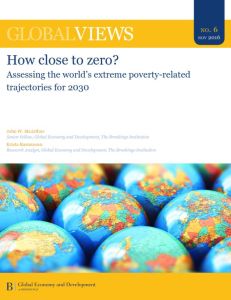Join getAbstract to access the summary!

Join getAbstract to access the summary!
John W. McArthur and Krista Rasmussen
How Close to Zero?
Assessing the World’s Extreme Poverty-Related Trajectories for 2030
Brookings Institution, 2016
What's inside?
Some countries are further along than others in eliminating dire poverty.
Recommendation
In September 2015, member states of the United Nations unanimously adopted Sustainable Development Goals (SDGs) that seek to end extreme poverty by 2030. This expert report from researchers John W. McArthur and Krista Rasmussen assesses whether 193 nations are on track to meet those SDG targets. Some of their findings are encouraging, while other results indicate there’s much work ahead for the global community. getAbstract recommends this important study to activists, economists and others interested in worldwide sustainability issues and in how countries are handling them.
Summary
About the Authors
John W. McArthur is a senior fellow at the Brookings Institution, where Krista Rasmussen is a research analyst.


















Comment on this summary